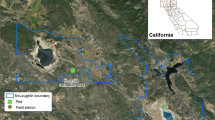Abstract
Functional diversity is significant to ecological processes of plant communities. We analyzed the variation of functional diversity of endangered species, Cercidiphyllum japonicum, communities along an elevational gradient in the Shennongjia Reserve, central China. Sixty plots of 10 × 20 m from 1,350 to 2,050 m were set up and species composition, traits and environmental variables were measured and recorded. These data were analyzed using five functional diversity indices, functional attribute diversity, modified functional attribute diversity, plot based functional diversity, community based functional diversity and Rao’s functional diversity indices (Rao’s index), Functional diversities of C. japonicum communities were rich and varied greatly. Functional diversity declined non-linearly with increasing elevation. Functional diversity was significantly correlated with species richness and heterogeneity. Elevation was a key environmental variable influencing functional diversity and species diversity. The five functional diversity indices were all effective for measuring functional diversity of communities. Functional diversity can be used as an indicator of conservation efficiency of endangered species such as C. japonicum.



Similar content being viewed by others
References
Austrheim G (2002) Plant diversity patterns in semi-natural grasslands along an elevational gradient in southern Norway. Plant Ecol 161(2):193–205
Butterfield BJ, Suding KN (2013) Single-trait functional indices outperform multi-traitindices in linking environmental gradients and ecosystem services in a complex landscape. J Ecol 101:9–17
Casanoves F, Pla L, Di Rienzo J, Diaz S (2011) Diversity: a software package for the integrated analysis of functional diversity. Methods Ecol Evol 2:233–237
Cornwell WK, Schwilk DW, Ackerly DD (2006) A trait-based test for habitat filtering: convex hull volume. Ecology 87:1465–1471
de Bello F, Lepš J, Sebastia MT (2006) Variations in species and functional plant diversity along climatic and grazing gradients. Ecography 29:801–810
de Bello F, Thuiller W, Lepš J, Choler P, Clement J, Macek P, Sebastia M-T, Lavorel S (2009) Partitioning of functional diversity reveals the scale and extent of trait convergence and divergence. J Veg Sci 20:475–486
Diaz S, Lavorel S, de Bello F, Que′ tier F, Grigulis K, Robson TM (2007) Incorporating plant functional diversity effects in ecosystem service assessments. Proc Nat Acad Sci USA 104:20684–20689
Fu S, Hu H, Zhang Q (2012) In vitro propagation of katsura tree (Cercidiphyllum japonicum Sieb. Et Zucc) an endangered plant in China. Afr J Biotechnol 11:14911–14919
Guan KJ (1979) Flora of China, vol 27. Sience Press, Beijing, pp 22–24 (in Chinese)
Liu M (2009) Research development of endangered species, Cercidiphyllum japonicum. Sichuan. For Des 3:18–22 (in Chinese with an English abstract)
Mason N, Mouillot D, Lee W (2005) Functional richness, functional evenness and functional divergence: the primary components of functional diversity. Oikos 111(1):112–118
Petchey O, Gaston K (2002) Functional diversity (FD), species richness and community composition. Ecol Lett 5(3):402–411
Petchey O, Gaston K (2006) Functional diversity: back to basics and looking forward. Ecol Lett 9(6):741–758
Pielou EC (1975) Ecological diversity. Wiley & Sons, London, pp 1–205
Rao CR (1982) Diversity and dissimilarity coefficients: a unified approach. Theor Popul Biol 21:24–43
Ricotta C, Moretti M (2008) Quantifying functional diversity with graph-theoretical measures: advantages and pitfalls. Community Ecol 9(1):11–16
Song NQ, Zhang JT (2013) An index for measuring functional diversity in plant communities based on neural network theory. J App Math. doi:10.1155/2013/320905
Tilman D, Reich P, Knops J (2001) Diversity and productivity in a long-term grassland experiment. Science 294(5543):843–845
Villéger SN, Mason WH, Mouillot D (2008) New multidimensional functional diversity indices for a multifaceted framework in functional ecology. Ecology 89:2290–2301
Walker BH, Kinzig A, Langridge JL (1999) Plant attribute diversity, resilience, and ecosystem function: the nature and significance of dominant and minor species. Ecosystems 2:95–113
Yuan S, Meng AP, Li LQ (2012) Effects of mountain body on genetic structure of Cercidiphyllum japonicum in Shennongjia. Plant Sci 30(4):358–365
Zhang JT (2011) Quantitative ecology, 2nd edn. Science Press, Beijing, pp 20–302 (In Chinese)
Zhang CM, Chen WL, Tian ZQ, Xie ZQ (2005) Altitudinal pattern of plant species diversity in Shennongjia Mountains, central China. J Integr Plant Biol 47:1431–1449
Zhang M, Xie ZQ, Xiong GM, Zhang JT (2006) Variation of soil nutrition in a Fagus engleriana Seem.-Cyclobalanopsis oxyodon Oerst. community over a small scale in the Shennongjia Area, China. J Integr Plant Biol 48(7):767–777
Zhang JT, Fan LH, Li M (2012a) Functional diversity in plant communities: theory and analysis methods. Afr J Biotechnol 11:1014–1022
Zhang JT, Song NQ, Li M (2012b) Application of fuzzy equivalence clustering to the analysis of functional diversity in plant communities. Proceedings of 2012 9th international conference on fuzzy systems and knowledge discovery, vol 2. IEEE & CAS, New York, pp 556–560
Zhang JT, Song NQ, Fan LH (2013) Evaluation of nine distance-based measures of functional diversity applied to forest communities. Ann For Res 56(1):43–52
Author information
Authors and Affiliations
Corresponding author
Additional information
Project funding: The study was financially supported by the National Natural Science Foundation of China (Grant No: 31170494) and the Specialized Research Fund for the Doctoral Program of Higher Education (Grant No. 20120003110024).
The online version is available at http://www.springerlink.com
Corresponding editor: Zhu Hong
Rights and permissions
About this article
Cite this article
Zhang, J., Zhang, B. & Qian, Z. Functional diversity of Cercidiphyllum japonicum, communities in the Shennongjia Reserve, central China. J. For. Res. 26, 171–177 (2015). https://doi.org/10.1007/s11676-014-0010-z
Received:
Accepted:
Published:
Issue Date:
DOI: https://doi.org/10.1007/s11676-014-0010-z




